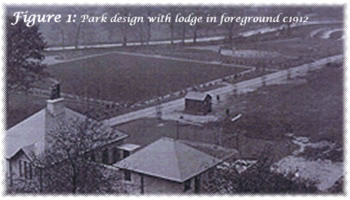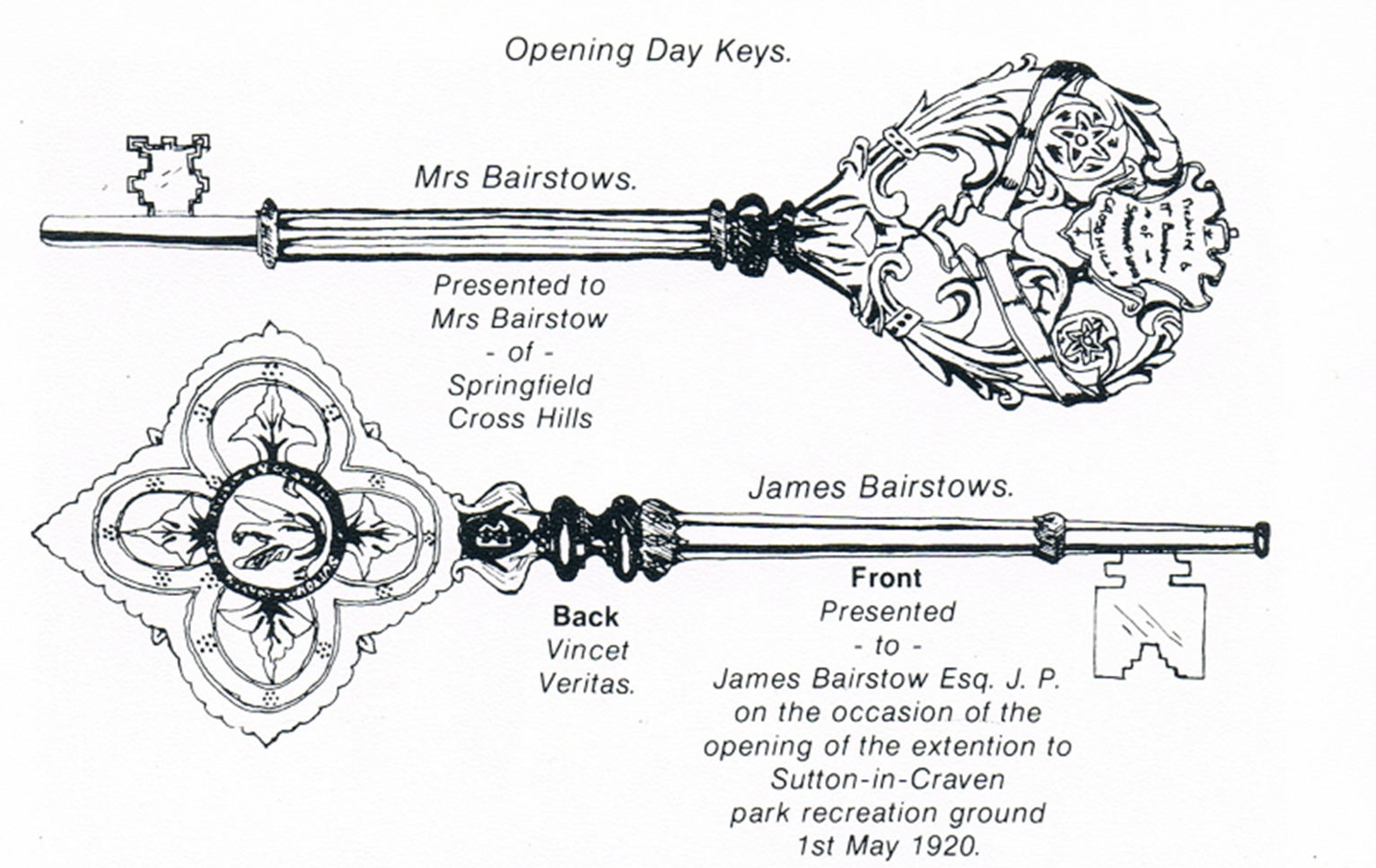“...Sutton might be proud that there is no other village in Yorkshire or in the rest of England, with a recreation ground so adopted to its needs.”
One Hundred Years Of Sutton Park
There cannot be many parish councils who have maintained their own public park for one hundred years and we congratulate their efforts.
On opening the park on 20th July, 1912, Sir John Horsfall said that “...Sutton might be proud that there is no other village in Yorkshire or in the rest of England, with a recreation ground so adopted to its needs.”
Sutton-in-Craven is sited on the southern edge of the Airedale valley, on a shallow terrace where the Sutton Beck combines with the Holme Beck before the confluence with the River Aire. The village expanded in the 19th century as an industrial Mill town.
The two old communities, notably Sutton-in-Craven and Sutton Mill and Sutton, are linked by Sutton-in-Craven Park which is the central focus of the village both geographically and socially and a very important feature and asset.
Like a village green, it has many key community buildings on its fringe notably the Church,
Primary Schools, Mill (now residential) and pub.
The park is a good example of an early 20th century design scheme for a public park. The design of the park remains extraordinary close to the original in 1912 design, as shown by early photographs, and subsequent plans.
South of the park, is the older part of the village. St Thomas’ Church and the Church of England Primary School (both c1869), are situated across Main Street opposite the park’s main entrance.
Greenroyd Mill (now developed for housing), which originally belonged to Hartleys the worsted spinners and was later bought by the Bairstows, lies opposite the park at Bull Bridge, its southern tip. To the north, stood Sutton Mill (now residential) Sutton Mill was largely developed to serve the woollen mill of T & M Bairstow from the middle of the 19th century.
The Council Primary or Community School as it is now known, established in the 1890’s is situated immediately to the north of the park with Sutton Baptist Chapel, demolished and rebuilt in 1972, across Holme Lane opposite the pond.

The land for Sutton-in-Craven Park was donated in three stages by local mill owners, John William Hartley of Sutton Hall and James Bairstow JP of Springfield. It consisted of meadow and pasture, originally called Otter Holes, East Field and Higher Stone Haw. In the 19th century Otter
Holes had been used for a travelling circus and fairground.
The first bequest was made at the death in 1909, of John William Hartley. He bequeathed to the Parish Council 4,527 acres of the land known as Otter Holes along with a small garden near Black Bull Bridge to be used for a public recreation ground or park. He stipulated that only a caretakers lodge, shelters and lavatories should be built and these were not to exceed more than one storey in height. In addition to the land, he bequeathed £1000 for laying out and planting and a further £1,000 to be invested to provide a maintenance fund for the Park.
In 1911 the Parish Council accepted the donation of a further 0.93 acres of adjoining land to the east (East Field) from James Bairstow JP, its Chairman. The land was for use as a recreational ground and playground thus the second gift added an area specially for recreational facilities, ornamental planting, walks and traditional park uses. Finally in 1920 James Bairstow gave a further 1.08 acres of land adjoining the park in memory of the young men who had come through the Great War. The land, part of East Field and Higher Stone Haw, was also to be used as a recreation ground—and for no other purpose.

The park was officially opened by Mrs Bairstow, wife of James Bairstow , on 20th July, 1912.
The design of the core area of the park, that was donated in 1909 and 1911, is the work of Fred Moore, architect, of Moore & Crabtree, Keighley.
Laying out the ground and planting more than 1,000 trees and shrubs was contracted to Tom Kershaw & Sons Limited, landscape gardeners, nurserymen, seed and bulb merchants, of Bleak House Nurseries, Cross Roads, Keighley.
After the park was opened, in the autumn of 1912, Kershaws also supplied bulbs for the park. Little is known of Fred Moore; indeed there may have been a father and son of the same Christian name. Fred Moore’s obituary in the Yorkshire Observer, 1951 indicates that he was born in 1860 and later in his architectural career went into partnership with Mr J Crabtree, with whom, as Moore and Crabtree, he was responsible for the construction of many mills and works in West Riddlesden. Among the Keighley undertakings he was involved with the building of Hattersley Crescent and the planning of Cavendish Street. Sutton-in-Craven Park was the work of Fred Moore senior.
The nursery of Tom Kershaw & Sons Limited was established in 1882 and the business appears to have included a florist’s shop and seed, bulb and tool warehouse in Keighley as well as the landscaping and nursery business. The business no long exists, however, it is possible that it was a major nursery and landscaping business in the area at the time.
The design of the park seems little changed from the original layout in 1911 which adopted a strong north-south axis reinforced by making a lime avenue along the length of the main drive. It was a design which exploited the shape and topography of the site and ingeniously divided the areas donated by the two mill owners, who had each given their gifts of land for different, albeit related purposes. Bairstow wished his gift to be laid out as a traditional park. Hartley wished his to be developed for recreation.
The main gates and piers which are on the southern boundary, link the older community of Sutton to the park. The main drive is aligned on the gable of the Church of England Primary School at this southern edge. Kershaws were responsible for site preparation although some of the park grass may have been retained from the meadow and pasture already on the site. Features proposed by Mr Bairstow were all incorporated notably the single storey caretakers lodge, lavatories, two pavilions, (shelters), the pond, bowling green, tennis courts, promenade and paths, boundary wall, railings and gates. The pond at the lower, northern end of the park, is a serpentine feature drawing its
water supply from the adjoining Sutton Beck. It is stilled filled and emptied by the original method of an inlet and outlet from the beck.
Most of the original trees on the site when the park was laid out, have now been lost, particularly the elms (which were possibly the young trees moved to within the southern boundary during the 1911 road widening).

The top and bottom shelters were specially constructed for the park and similar to shelters in Harrogate and Ilkley, whilst the Scarborough Seats which were given when the park was opened, have their own distinctive cast iron bench ends featuring the flower emblems of England,
Scotland, Ireland and Wales centred around a crown inset with the letters S.P. and with a ram’s head terminating the arm rest. Sadly many of these have been stolen. We know from accounts that the park structures were painted Buckingham Green.
The opening of the extension to the recreation area in May, 1920 included maypole dancing, which became an annual event, along with the crowning of a May Queen and general festivities.
In 1921 the War Memorial was unveiled, the names of the fallen listed on bronze plaques. The Stocks formerly situated near to the Kings Arms, then moved nearer the Baptist Chapel, later used for gate stoops at Bow Hill were moved to the park and two new grass tennis courts were made near the original courts. 1923 Mrs Bairstow donated an additional shelter which was sited towards the middle, on the east side of the main drive, overlooking the recreational area. It was her wish that it should be particularly for the benefit of the ladies who used the park—no doubt it would give good views for mothers watching children using the recreation area.
By this time the park had become much-loved and much-used by all ages including pupils from the two neighbouring schools and for gatherings such as coronation celebrations and jubilees The putting green was made in 1925 and the maypole moved to the south of the new shelter. In 1926 swings were donated. By the late 1930’s the Parish Council had bought a new green house for the Park Keeper “for the purpose of raising bedding plants” and about £1 was spent each year on flower seeds. In 1949 a slide and a clock for the bowling green pavilion was donated.
30th April 1950 the Second War Memorial tablet was unveiled, five hundred programmes were printed for the unveiling. From 1952 it is evident that the cost of park maintenance was becoming a worry for the Council and it was decided to reduce the area of the putting green, to prune
the bushes in the border on the west of the main drive and to enlarge the perennial herbaceous area.
In the 1960’s further children’s play equipment was installed on the recreation area. The golden jubilee of the WI (Women’s Institute) was celebrated by the members planting four dozen rose bushes in the bed near the top shelter in 1965. In 1976 a request was put to the Parish Council by the bowling club for a new pavilion.
In 1977 it was decided to erect a pavilion with toilets in honour of the Queen Elizabeth II Silver Jubilee. Many funding events took place including a sponsored walk twenty times around the park by the school children who raised the sum of £1,500. The Jubilee pavilion was opened in May 1978. Mr A. D Bateman a former resident and a member of the Bairstow family was chosen to open the building. The cost to the parish council was £6000, the pavilion was handed over to them for maintenance at the ceremony.
Recently repairs to the parks infrastructure have taken place, the Pavilion extended, refurbished and opened as a Tea Room. A multi use games area established, Victorian style street lighting installed and new play equipment provided.
With limited income, the costs of maintaining the park by such a small community have been, and continue to be, a major concern and it is a credit that the park remains as it was originally intended.
Sutton-in-Craven can still be proud of its park. No doubt John Hartley and James Bairstow would be pleased.